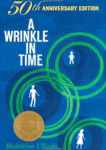One thing of all dim things I know is true,
The heart within me knows, and tells it you,
And tells it you.
from Evening Song by Willa Cather
We’ve left good ol’ Earth behind. We’re now in the realm of the Happy Medium, the Man with the Red Eyes, and some sort of time-traveling shortcut called a tesseract, illustrated with actual drawings featuring an ant and a skirt.
Amid so many dim things, how can Meg know what to do? Who to believe? She needs her heart.
Meg and her companions now know that the Black Thing has been shadowing Earth for many years. “That is why your planet is such a troubled one,” Mrs Whatsit says.
I think of this exact dark image every time I read the news and get overwhelmed. My planet is troubled because it’s shadowed: Madeleine L’Engle told me so. Why did I expect perfect weather and everlasting health?
It is time to be brave. And bravery, we learn in these chapters, is always sacrificial.
‘It was a star,’ Mrs Whatsit said sadly. ‘A star giving up its life in battle with the Thing. It won, oh, yes, my children, it won. But it lost its life in the winning.’”
And so, our trio sets off to battle. Off to the bizarre sameness that is Camazotz, off to the oppressive building marked CENTRAL Central Intelligence. It is in this space that they lose Charles Wallace; or rather, he loses his mind to IT, the book’s incarnation of evil.
Like Meg, Charles Wallace is brilliant. His brain is more gifted than hers, blending extraordinary intelligence with an empathy that can peer into another person’s mind. But his heart? It’s a little boy’s heart.
Meg’s older, wiser heart knows what’s true and tells her what’s true. She follows her heart.
That’s how she knows instinctively, even before Calvin does, that Charles Wallace is no longer Charles Wallace. That’s how she knows the man trapped in the transparent column is Father.
Meg’s heart is a manifestation of her emotional intelligence. Because she’s a teenager, she’s still maturing in this area, but her core is solid. She knows the Mrs’s are not witches, although they don’t mind dressing that way. She instantly recognize that a world where no one is unhappy means a world where no one is happy, either.
But can she be a star? Can she let herself go dim to defeat the darkness? Only the heart within her knows.
For Discussion or Journaling
1. Where do you see emotional intelligence in your own life? How do your feelings, even the not-so-pleasant ones, make you smarter?
2. Chapter 7 has a scene centered around food that is not what it seems. Write about a significant meal in your life.
3. Camazotz is a world where all is safe and nothing is good. How can wildness lead us to beauty?
We’re discussing Madeleine L’Engle’s classic A Wrinkle in Time this month.
We’re also using the poem Evening Song by Willa Cather as a guide. Join us as we tesser through this Newbery-winning classic. Next week we’ll read chapters 9-12.
Photo by Jeff Turner, Creative Commons, via Flickr. Post by Megan Willome.
Catch up on the other A Wrinkle in Time posts.
“Megan Willome’s The Joy of Poetry is not a long book, but it took me longer to read than I expected, because I kept stopping to savor poems and passages, to make note of books mentioned, and to compare Willome’s journey into poetry to my own. The book is many things. An unpretentious, funny, and poignant memoir. A defense of poetry, a response to literature that has touched her life, and a manual on how to write poetry. It’s also the story of a daughter who loses her mother to cancer. The author links these things into a narrative much like that of a novel. I loved this book. As soon as I finished, I began reading it again.”
—David Lee Garrison, author of Playing Bach in the D. C. Metro
- Perspective: The Two, The Only: Calvin and Hobbes - December 16, 2022
- Children’s Book Club: A Very Haunted Christmas - December 9, 2022
- By Heart: ‘The night is darkening round me’ by Emily Brontë - December 2, 2022



Laura Bo says
Even when I was young the image L’Engle paints of the sameness of Camazotz was the creepiest. I think the brilliance of L’Engle’s writing is how she seems to capture so well all the angstiness (I’m making that a word) of those adolescent years. When Meg says that bit about not liking being different, but not wanting to be like everyone else, well… that must have made my young angsty heart feel like it had found a home. Wow, reading through this again is stirring all the feels. Thanks for being our wise guide, Megan.
Megan Willome says
Laura, I always found Camazotz very creepy too. I can still call to mind the images I created when I first read the book.
And yes, angstiness is the right word. What I wanted at that age was to be able to save someone … anyone … from anything (didn’t have to be the world). With Meg, L’Engle helped me imagine it,